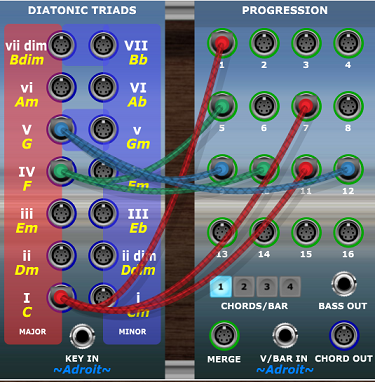
Introduction
The Progression module is a specialized Adroit sequencer that works in conjunction with chord modules to create chord progressions.
Like all Adroit Synthesis sequencers, the Progression module uses the V/Bar standard where time is represented by a voltage rather than being dependent on clock signals.
Chord signals use Adroit S-Poly connections.
Chord progressions are programmed by patching chords signals into the input sockets. This can be done directly with cables or by using Virtual Modular’s bus system.
Apart from the very first input, chords need only be fed to inputs where a chord change occurs.
The layout of the input sockets reflects the commonly used notation for chord progressions.
So for instance one of the most basic 12 bar blues chord progressions is notated as follows.
| I | I | I | I |
| IV | IV | I | I |
| V | IV | I | V |
This chord progression could be implemented in LSSP using cables like so…

Or perhaps more elegantly by using bus connections like so…

A hybrid approach works too. Below a couple of I7 chords are added to spice up the progression a little…

The CHORD OUT socket transmits the current chord in the sequence. This chord signal might be used, for instance, to feed one or more Chord Player modules which output polyphonic MIDI note on and note off messages when they receive a gate.
The BASS OUT socket transmits the pitch voltage of the lowest note in the current chord. It can be handy for the production of simple bass lines.
The V/BAR IN socket is fed with a V/Bar signal that controls which step in the progression is selected and fed to the CHORD OUT and BASS OUT sockets.
Progression is in effect a 16-to-1 16 pole voltage controlled switch with a few trimmings.
Chord signals are provided by Adroit modules such as Chord, Diatonic Triads, Chord Memory and Chord From Scale or can be custom made using Chromatic Scale and Mono to S-Poly.
The Progression module can handle a progression of up to 16 steps. The length of time this represents depends on how quickly you want chord changes to occur.
Use the CHORDS/BAR buttons to select how quickly chords can change, from once per bar to four times per bar.
When CHORDS/BAR is set to 1 the module can sequence a progression of up to 16 bars in length.
When CHORDS/BAR is set to 2 the module can sequence a progression of up to 8 bars in length.
When CHORDS/BAR is set to 3 or 4 the module can sequence a progression of up to 4 bars in length.
If you are producing high tempo electronic dance music then chords don’t typically change more often than once per bar but the Progression module offers enough flexibility to support all manner of genres.
If the chord progression is the same length as a section of the song (or you want the progression to loop) then this module can be directly connected to the V/Bar output of a Song Part module.
If you want to program a chord progression with more steps than available in a single module then multiple Progression modules can be chained together using Song Part or Time Splitter modules and the MERGE socket.
Tutorial link
The Progression module is introduced in LSSP 101 Tutorial 3.
Availability
The Progression module is available in both LSSP XL and LSSP 101.